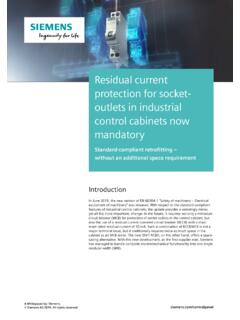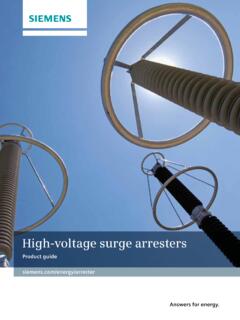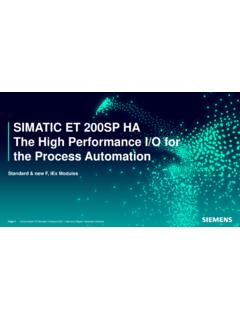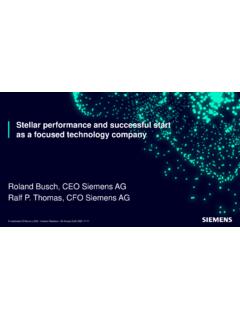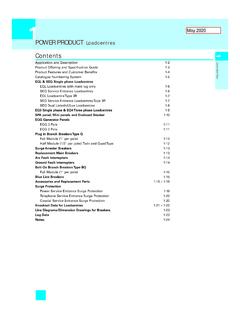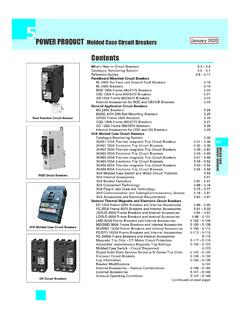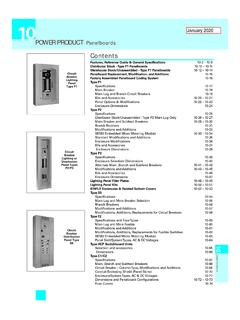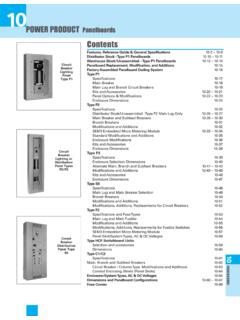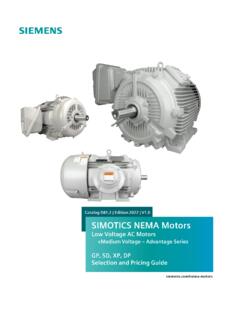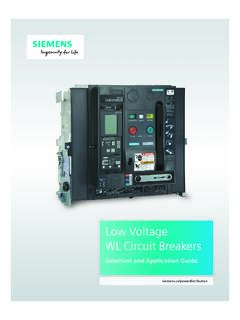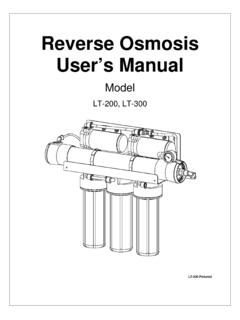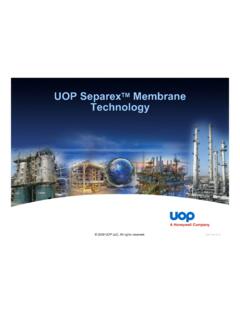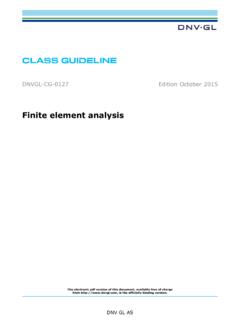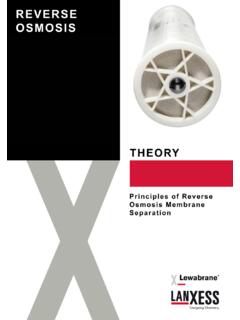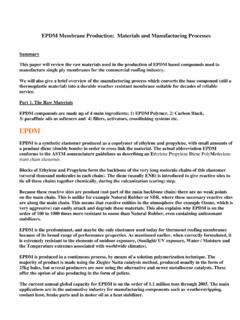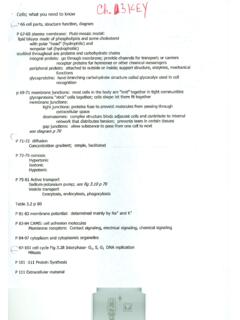Transcription of SINAVY PEM Fuel Cells - Siemens
1 PEM Fuel CellsFor SubmarinesContentsIntroduction3 PEM Fuel Cells : Function and design6 PEM Fuel Cells : Modules and power plant8 Outlook11 Fuel Cells enable the direct generation of electric power from hydrogen and oxygen with significantly higher effi-ciency, with noiseless operation and without pollutant emissions compared with conventional combustion propulsion (PEM FC)Space shuttleAir-independent power supply (PEM FC)Storage system for regenerative energiesSiemens Electrolyzer (PEM FC)RailroadElectrical propulsion (SOFC, PEM FC)Gas tankerElectrical propulsion (SOFC, PEM FC)BusEmission-free and noiseless operation (PEM FC)Delivery trucksEmission-free and noiseless operation (PEM FC)H2O2H2/airReformer gas/airReformer gas/airFuel Cell power plantsPresent and future applicationsFig. 1: Possible applications for fuel cell power plantsApplication potentialDecentral power plantsGrid-independent operation (SOFC, PEM FC)FreighterEmergency power supply (PEM FC)Passenger carEmission-free and energy- efficient operation (PEM FC)4In addition to these basic advantages, the fuel cell with a solid, ion-conducting, polymeric membrane (polymer electrolyte membrane PEM) has more positive properties: Quick switch-on, switch-off behavior Low voltage degradation and long service life Favorable load and temperature-cycle behavior Capability of overload operation Low operating temperature (80 Celsius) Absence of a liquid-corrosive of these characteristics make the SINAVY PEM Fuel Cell an ideal power unit.
2 Aboard submarines they show their outstanding advantages over other AIP (air-independent propulsion) systems for conventional submarines. Using oxygen and hydrogen stored in liquid or gaseous form on board as reactants, the only process result besides electricity, waste heat and small amounts of residual gases which are given into the boats atmosphere is process water. This process water can be used for different purposes, such as weight balancing to avoid process-related needs for trim adaptions of the submarine. Siemens offers two types of SINAVY PEM Fuel Cell modules for your selection the FCM 34 and the FCM of Class 212A (six in the German Navy and four in the Italian Navy) are equipped with FCM 34 modules, which were developed from 1984 at the request of the German Ministry of Defense. Submarines of Class 214 operated by the Hellenic Navy, Republic of Korea Navy, Portuguese Navy, and in future by the Turkish Navy are equipped with FCM 120 modules, which were developed in a later phase.
3 Development work is ongoing either improving existing modules or designing future 2 Operational submarines of Class 209 can be upgraded with an additional fuel-cell power plant during refit, and so acquire the benefits of air-independent propulsion (AIP) at a much lower price than for acquiring a new AIP-sub-marine. The impressive advantage of the AIP Technology, which is basing on fuel- Cells , has been demonstrated on board of submarines of classes 212A, 214, and Dolphin Fuel Cells : Function and designA simplified representation of the SINAVY PEM Fuel Cells basic function and design is shown in (Fig. 3): the electrochemical element at which the chemical energy is converted into electrical energy is the membrane electrode unit. It consists of the polymer electrolyte, the gas diffusion electrodes with a platinum catalyst and carbon sheets on each side. After the abstraction of the electrons from hydrogen they flow from the anode via the electrical load to the cathode the resulting protons migrate from the anode to the cathode where they combine with oxygen (and the electrons) to form water.
4 The theoretical voltage of an H2/O2 fuel cell is V ( referred to the upper heat value of hydrogen). At zero-load conditions, slightly more than one volt per cell is available. The cooling units or bipolar plates, in combination with carbon diffusion layers, distribute the reactants uniformly across the area of the cell, conduct the electrons across the stack, remove the heat from the electrodes, and sepa-rate the media from each other. Figure 4 shows the two core components of a cell with outside dimensions of 400 x 400 mm, as used in FCM 34 modules. Figure 5 compares the bipolar plate of the FCM 34 modules to the FCM 120. Two Cells of the FCM 120 produce about twice the power of one cell of the FCM 34 type with nearly the same active area. Cooling unit400 mmCooling unitMembrane electrode unitFig. 4: Components of cellFig. 5: Comparison of Cells : FCM 34 Type (back), FCM 120 Type (front)6 The theoretically high development potential in regard to the membrane material is shown in Figure 6.
5 With im-proved materials, the power density can be nearly doubled. The voltage of a SINAVY PEM Fuel Cell with respect to the operating time is stable, and degradation rates are less than 2 V/h per cell for FCM 34 module. Significantly lower values were achieved during the operation of a FCM H2 Oxygen O2 Electrical load 4e 2H2 + 4e = 4H O2 + 4e = 20 20 + 4H = 2H2 OAnodeCathodeH H H Product water H2O + O2 Polymer electrolyteWaste heatFig. 3: Functional principleFig. 6: Potential output increases by using various electrolytesCell Voltage [UC/V]Cell Output PC/WNaf 115 Naf 115 Naf 117 Naf 117 Current ,000800600400200005001,0001,5007 PEM Fuel Cells : Modules and power plantPEM Fuel Cell modulesSiemens has put every effort into integrating the PEM Fuel Cell stack, valves, piping, and sensors as well as the corre-sponding module electronics control and the ancillaries into a single container making the best use of the limited space on board.
6 The ancillaries comprise the equipment for supplying H2, O2, and N2 for reactant humidification, for product water, and waste heat and residual gas removal. The container is filled with N2 inert gas at bar abs. to prevent a release of H2 and/or O2 in case of leakages. Thus, the operator can use the PEM Fuel Cell as a working black box without having to care about the processes inside the container. The PEM Fuel Cell module can be operated at various static and dynamic load currents. Currents below 650 A for FCM 34 modules or below 560 A for FCM 120 modules can be applied in continuous operation. The output power/current characteristics for FCM 34 modules are shown in Figure 7. For currents above the rated current, the loading time is limited due to insufficient heat removal at these values. Even loads up to double the rated current can be applied for a short time. At the rated operating point, the overall efficiency is approximately 59 percent with respect to the lower heat value of H2 (LHV).
7 It increases in the part-load range, reaching a maximum of approximately 69 percent at a load factor of some 20 percent of the rated current ( approximately 100 A) (Fig. 8). The properties of the FCM 34 and FCM 120 modules are listed in the table on page Fuel Cell power plantAppropriate operating conditions for fuel-cell modules are provided for submarine applications by a fuel-cell system in which fuel cell modules are connected to the hydrogen and oxygen supply to disposal units for functions like cooling residual gas reaction water to auxiliary systems for functions like inert gas drying degasing for cooling fluid nitrogen supply evacuation system to the propulsion/ship s system as to supply it with demanded electrical powerOperator control and visualization of the fuel-cell system are facilitated by the integrated platform management system or directly via the control panel of the fuel-cell system.
8 Figure 9 gives a simplified overview of the AIP system. The fuel-cell system in its entirety the complete fuel-cell power plant, especially the supply and disposal systems described above for AIP operation, including spatial and functional integration on board has been developed by HDW (Howaldtswerke Deutsche Werft AG). The submarine classes 212A, 214, and Dolphin are equipped with the new fuel-cell power plant by HDW based on SINAVY PEM Fuel Cells modules by Siemens . An AIP system with SINAVY PEM Fuel Cells modules can be added to existing output [kW]07001,400 Current [A]1601801,050350 Fig. 7: Performance Data of FCMsFig. 8: Efficiency of FCM 34 and 12080706050403020100 Efficiency [%/h0]08001,0002004006001,200 Current [A]FCPP peripheral devices: oxygen hydrogen product water residual gases cooling system evacuation ..Boat Main Switch-boardBoat Main Switch-boardFCPP Switchboard 1 FCPP SwitchboardFCM 34abConverterFCM 120 FCPP Switchboard 2 EMCSFig.
9 9: Two types of fuel-cell power plants (FCPP) a: fuel-cell battery with FCM 34; direct coupling of FC voltage to boats mains at class 212A submarine b: fuel-cell battery with FCM 120; coupling via converter at class 214 submarineEMCSFCM 34 FCM 120 FCM 34 FCM 1209 Fig. 11: Comparison of installed/contracted AIP SystemsFig. 10: PEM Fuel Cell modules assembled in a test rackTechnical dataFCM 34 FCM 120 Rated powerapprox. 34 kWapprox. 120 kWVoltage rangeapprox. 54 VDCapprox. 215 VDCE fficiency at rated load> 58%> 53%Efficiency at 20 % loadapprox. 71%approx. 68%Operating temperature70 75 Capprox. 70 CH2 bar bar bar bar = 47 cm W = 47 cm L = 143 cmH = 50 cm W = 53 cm L = 176 cmWeight (without module electronics)630 kg930 kg35302520151050 Number of SubmarinesSiemens FCMS tirlingMesmaother FCMType of AIP System10 Summary and OutlookSINAVY PEM Fuel Cells modules BZM 34 and BZM 120 are well-established in the market.
10 They have proven their performance and reliability in extensive tests. There is also the possibility to repower and refit operational submarines with an AIP system with SINAVY PEM Fuel Cells modules. The SINAVY PEM Fuel Cells technology s field of application will be extended, when suitable reformers are available to produce hydrogen from liquid fuels, for example, methanol and diesel. Then, fuel Cells may become the sole power source for the submarines of the future. With the ongoing R&D work the SINAVY PEM Fuel Cells modules will be improved conti-nously following the future growing demands of reliability and by Siemens AG 2016 Process Industries and Drives Division Marine Lindenplatz 2 20099 Hamburg, GermanyE-mail: No. VRMS-B10018-00-7600 Printed in Germany Dispo 16600 TH 464-160495 BR to changes and errors. The information given in this document only contains general descriptions and/or performance features which may not always specifically reflect those described, or which may undergo modification in the course of further development of the products.
